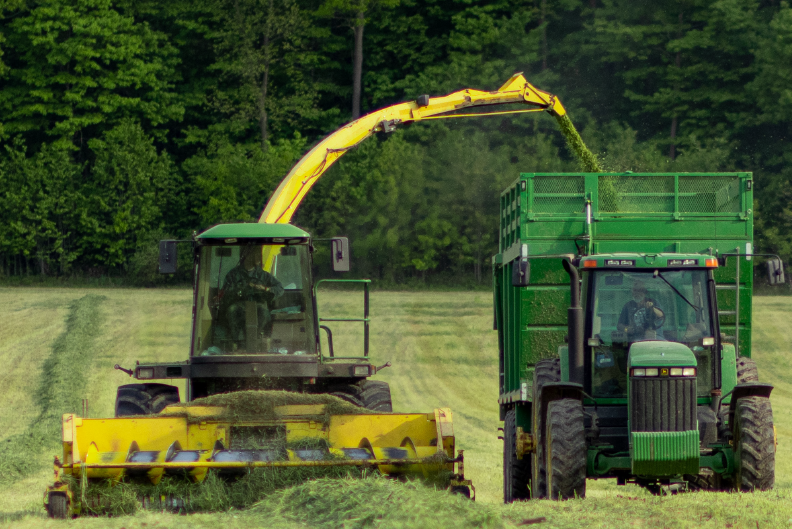Ruminant Nutritionist,
Grand Valley Fortifiers, Nutrition Direct
| Table 1: Current GVF PSPS TMR Recommendations | |
| Reccomendations | |
| Top | <9% |
| Middle | 50-60% |
| Bottom | <50% |
Currently, the NRC recommends a minimum of 25% NDF on a dry matter basis, with 76% of the NDF coming from forage. Chop length is very important to achieving NDF targets, a diet can contain adequate physically effective fiber, but because the forage is chopped so finely, it will not contribute to rumen health, and will have a negative impact on the gut microbiome. Ideally, a lower amount on the top sieve is recommended, this represents the most sortable portion of the diet. Current research is supporting a lower amount of material on the top sieve and maximizing the amount of feed on the middle sieve. Both the top and middle sieve will promote chewing and rumination and support a healthy rumen environment. If you do not have access to a PSPS shaker box, you can also look to your forage lab results. Increasingly, nutritionists are looking at the uNDF 240 hr number. This number gives us an idea of rumen fill and provides an indication of how much forage the cow can eat before she is full. The lower the uNDF240 number, the better. As the number decreases, this represents an opportunity for increased intake of forages. Higher forage rations are always preferred for cow health!
It is important to have the proper amounts of material on each sieve, an imbalance can lead to rumen upset. For example, a lack of effective fiber can lead to ruminal acidosis, with not enough fiber present in the diet to produce an adequate fiber mat. A reduction in chewable fiber or “chew factor” leads to a lower amount of saliva produced and material moving more quickly through the rumen, all equating to lower buffering capacity and feed not being fully digested. On the opposite end of the spectrum, if there is too much material on the top sieve, this can lead to excessive sorting and the potential for slug feeding. Sorting occurs when cattle move around their feed to sift out the concentrates to get to the “goodies” first. This doesn’t mean that they will not eventually eat the longer stemmed particles but often it is the cow last to the feed bunk that will eat it out of desperation. This is when we see manure inconsistencies in the barn. When concentrates are consumed first, rumen pH is negatively affected and proper digestion is inhibited, leading to inadequate nutrient absorption, potential rumen acidosis, and a reduction in milk production.
When should you speak with your nutrition advisor about running a PSPS shaker box or conducting a full TMR audit?
- A large change in forage proportions has happened.
- You are switching into a new cut of forage.
- The cows appear to be consuming less feed or there are more leftovers than usual.
- You are noticing loose manure, undigested feed particles in the manure or a change in milk production or fat.
Your dairy specialist will be able to determine what the best course of action is.
If you are looking to check your TMR to ensure that the proportions of fiber are meeting GVF recommendations, your rep can take samples from the beginning, middle and end of the bunk to get an average of the mix. If you are looking for a full TMR audit, this consists of taking 10 samples along the bunk as the feed is being delivered to allow your advisor to determine if there are any inconsistencies in the mix. A consistently mixed TMR should look like Graph 1 i.e little variation in the feed delivered along the bunk and a uniform mix. Graph 2 shows an inconsistently mixed TMR leading to inconsistent intake across the herd.

It is also good practice to take a sample of leftover feed and perform a PSPS shaker box on this as well. Comparing leftover feed to fresh feed shows if any additional sorting is occurring. There should be minimal differences between the distribution of materials from the fresh and leftover shaker boxes. PSPS audits can also be done on individual forages during harvest while feed is being chopped, so that any changes to the chop length can be made while the feed is being ensiled.
The Penn State shaker box is a great economic tool that producers or their dairy specialists can routinely perform on farm. High forage diets, high forage intake and increased dry matter intake are key factors in optimizing milk production and reducing purchased feed costs on farm. Ensuring that your TMR is mixed uniformly is the easiest and quickest way to ensure that your cows are consuming a properly mixed ration thus optimizing herd performance.
This article was written for the Winter 2022 Dairy Eastern Dairy Grist. To read the whole Dairy Grist, click the button below.

